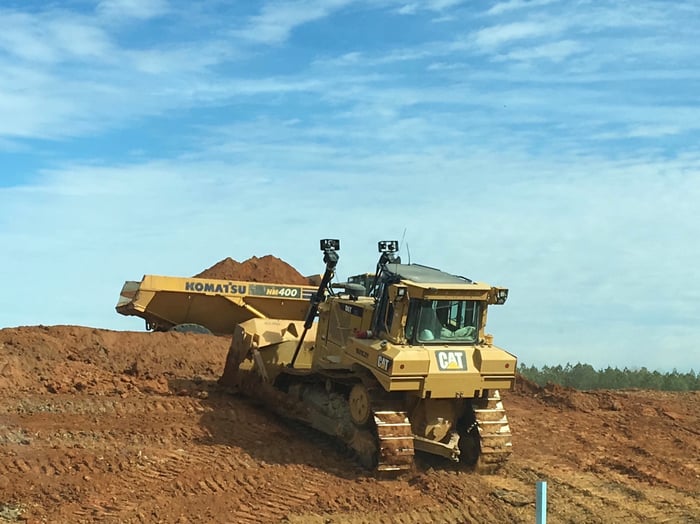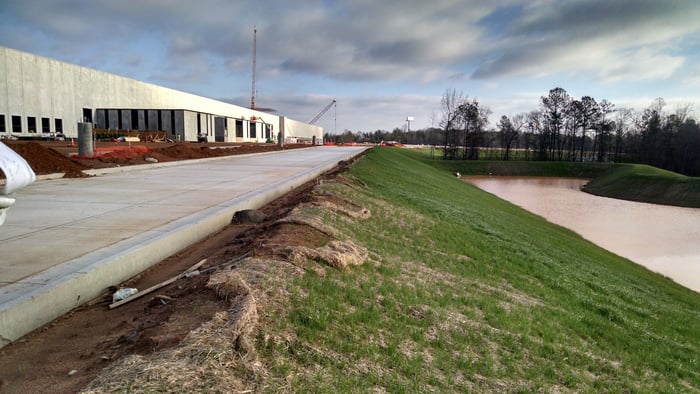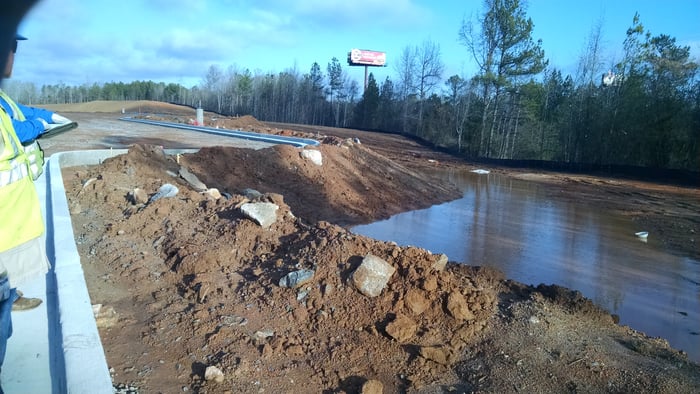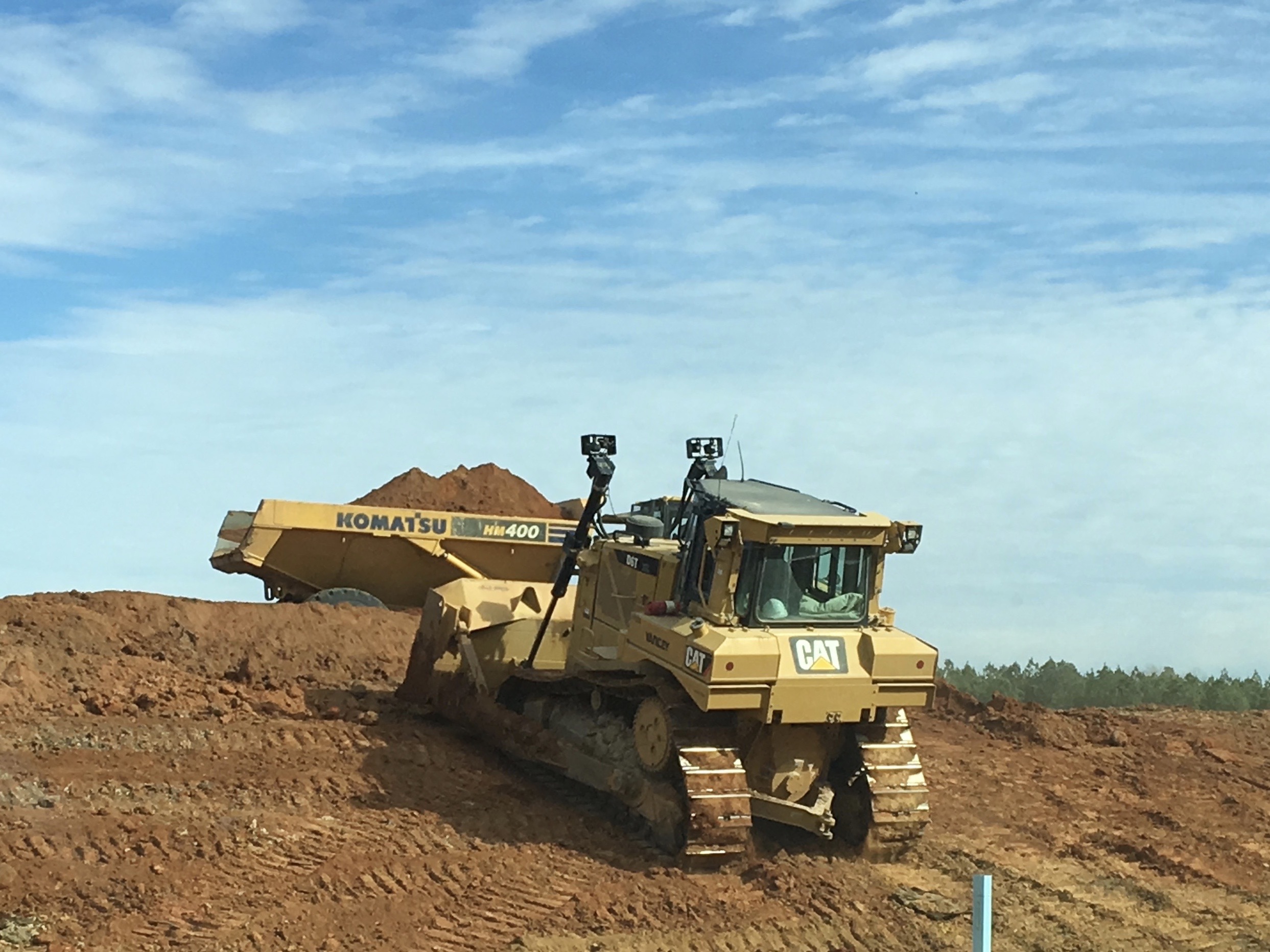What do you get when you take a massive building, surround it with pavement, then squeeze it onto just enough dirt to fit? Answer: steep slopes.
Georgia’s success in attracting large distribution centers and warehouses along its interstate corridors has been a boon for us, but it has also created some interesting challenges in site design and management, particularly in the hilly Piedmont region around Atlanta.
As a commercial landscape company that designs, builds and maintains the grounds around these big boys, we’ve seen some slopes that might be great for an Olympic bobsled run, but are hardly sustainable in the landscape. We understand the challenges and expenses involved with maintaining these. And, we hope to help you deal with them on your site by offering a few landscaping ideas for a slope in this article.
For those wanting more information on how to landscape a slope, I’m going to break this piece down into two categories: 1. sites that have already been built with severe slopes and 2. sites in the design or construction phase that are likely to wind up with them.

If You Have ‘Em…
Bless your heart. You’ve either been chewed out by somebody up the ladder because your slopes look like a jungle, watched with amazement while a dude with large cajones and a small brain slid a zero-turn mower side-saddle around them, or felt pity for the squad of men wielding weedeaters who spent all day slipping, sliding and dodging snakes to knock the tall stuff down. Said stuff then turns brown and lies there in messy clumps so somebody up the line can chew you out again because visitors are coming and it looks like the jungle was whacked down and left to die out front.
Yep, you are living the dream. If this is you, there is hope. Options include:
- Growth regulators and chemical mowing agents - These scientific wonders slow elongate growth. They are most effective on grasses, but also do a good job suppressing mixed vegetation. A good application will hold growth down for six to eight weeks easily, and we’ve managed nearly twelve weeks of effectiveness in some cases.
- Let it grow (but manage it properly) – Most engineers and landscape architects specify plants that are not supposed to be mowed for slopes over 3:1—the maximum slope for grass. Most facility managers want them to be mowed anyway because not many people care for the “wooly” look. If your slopes have weeping lovegrass, ask your landscape folks not to mow. Instead, specify the use of herbicide and handwork to keep saplings and woody weeds from growing up. The lovegrass is one of the absolute best plants for slopes. It will fully cover in a season or two and looks great when it does. It takes almost no maintenance thereafter to sustain. (If you have lespedeza, that’s another story, and a bigger problem. Call me when you have a few minutes.)
- Mow with the right equipment – we learned the hard way that zero-turns and even walk behinds are not the best option on steep, clay (read slick-when-wet) slopes. If you really want it mowed, hire a contractor that actually has a slope mower, which is designed to do this work safely. There are limits to what they can do too, though; most ride-on units will mow slopes up to 30 degrees. Remote control units claim up to 50 degrees and work well, but are kind of slow. Do not expect this service to come at a comparable price to regular mowing – these machines cost five to seven times more than a zero-turn, so per-hour rates are considerably higher.
- DO consider safety, and please rank it over low price. You can’t put a price on human life, and the potential liability consequences that come with inadequate slope maintenance are not worth the risk.

If You Are in the Pre-Design or Design Phase:
Lucky you! You have the opportunity to save a host of people a world of headaches and wasted money. The following landscaping ideas for a slope, when properly designed and executed, will improve your commercial or industrial site’s aesthetics, promote a safe environment, and spare your maintenance budget:
- Utilize landform grading to create a more natural, sustainable site. Landform grading is a type of slope design introduced in the 1970’s by a guy named Horst Schor. It’s based on the idea that Nature knows best. Instead of the usual artificial slope construction, a landform graded design seeks to preserve the natural topography of the land when possible, and mimic the way nature designs slopes and drainage systems. The result is a more natural-looking site that resists erosion and, when planted thoughtfully with appropriate trees and perennials for slopes, is easier and more cost-effective to maintain. It looks better and works better too.
- Use infiltration methods to reduce the need for storm water detention. Where you have slopes, you have runoff—and the need to deal with it. Conventional detention/retention methods can monopolize a lot of space on your site, and can be pretty ugly to boot. Why go there unless you have to? Depending on your site, you can reduce detention/retention need by using such methods as permeable pavements, bioswales and infiltration basins. These can often be incorporated into a site in ways that look natural and attractive, are better for the environment, and optimize land use.
- Use retaining walls and terraces for extreme slopes. For very steep slopes that can’t be otherwise dealt with, these solutions are da bomb. Terraces and retaining walls create more usable space on the property and allow for quick grade transitions without creating extreme slopes that are dangerous and difficult to maintain. Yes, they cost more to construct. But when you consider the lifetime value compared to the cost, hassle, and potential liability involved in trying to maintain an overly steep slope, they can be a bargain.

- Use appropriate plants for slopes. If you want it mowable and neat, lose the lespedeza and any other woodies. Instead, check out our top-pick perennials for slopes and erosion control. Or, if you really want the wooded look, may we suggest checking out our blog on the best shrubs and trees for slopes in Georgia. These plants will save you a lot of headaches.
- Plan ahead for safe and effective slope maintenance. Whatever solutions you settle on, keep in mind that maintaining slopes just plain requires more thought and attention than flat areas. Be sure your landscape crews understand your intention and are properly trained on safe maintenance methods for slopes. And be sure to set up specs for the maintenance people so they execute on the original intent. A little preparation goes a long way.
Slope Control for Georgia Industrial and Commercial Properties
Poorly designed slopes can get you sued, your company sued, and even lead to loss of life. Be they engineers, landscape designers, or a commercial landscape maintenance company, any contractors you use need to understand negligence and best practices for safety when it comes to slope design and maintenance.
Whether you’re already wrestling with untenable slopes on your property, or are in the planning phases and want to avoid potential disaster, we have the experience, expertise, and equipment to help. Give us a call today at 478-750-7733 or contact us online to learn more or request a quote.
1 Oct 2024


